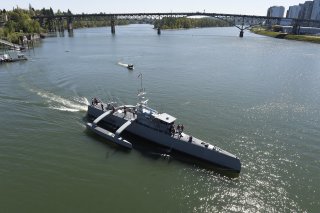Drone Crazy: The Navy Is Making Major Leaps with Its Unmanned Systems
The Navy just held a ribbon-cutting ceremony for the “first purpose-built and co-located facilities for unmanned maritime vehicle testing" in California.
It would not be an exaggeration to describe the Navy’s rapid acquisition of unmanned systems as a “drone explosion” given the number of new surface, air and undersea platforms.
The Navy now has large, medium, and small undersea and surface drones at various stages of development. The platforms range from unmanned submarine-like systems such as the XLUUV, or Extra Large Unmanned Underwater Vehicle, to small mine-hunting, semi-autonomous undersea drones, to surface drone platforms such as the Unmanned Surface Vehicle-Medium. New technologies are quickly reshaping concepts of operation for warfare.
Maritime warfare is expected to be defined by breakthrough weapons and sensors with greater range, precision, and data-transmission capability. Unmanned systems, and cross-domain networking form are the basis for next-generation warfare. Unmanned systems can conduct clandestine surveillance and reconnaissance missions or function as nodes within a larger, multi-domain warfare network. Advanced algorithms allow much greater degrees of collective or collaborative autonomy such that groups of unmanned systems can now operate in tandem with one another and adjust in real-time to changing combat variables. The advent of improved unmanned systems also allows manned platforms to operate as motherships or host platforms performing command-and-control at standoff distances.
Given this, it comes as no surprise that the Navy just held a ribbon-cutting ceremony for the “first purpose-built and co-located facilities for unmanned maritime vehicle testing,” located at Naval Base Ventura County (NBVC), Calif.
“These facilities will be the focal point of Navy learning and experimentation on the capabilities, operations and sustainment of Unmanned Maritime Vehicle prototypes to inform future programs,” Capt. Pete Small, Program Manager, Unmanned Maritime Systems, said in a Navy report.
The facilities will accommodate testing, evaluation, and technology demonstration for Extra Large Unmanned Undersea Vehicle (XLUUV) and Unmanned Surface Vessel prototypes.
The intent of the new facility is to support the Navy’s Distributed Maritime Operations strategy. Unmanned systems can support the need for longer-range, more distributed, yet closely networked warfare.
In addition to five Orca XLUUV prototypes, NBVC Port Hueneme will eventually accommodate one Medium Unmanned Surface Vessel, two Sea Hunter Unmanned Surface Vessels, and four Overlord Unmanned Surface Vessel prototypes, the Navy said.
The four Overlord USV prototypes seem quite significant, as the Overlord (or Ghost Fleet) program has achieved breakthroughs in coordination and multi-domain data sharing for several years now. The concept is to extend the premise of “autonomy” beyond the operations of a single vessel to enable a coordinated, collective autonomy where unmanned systems share and analyze information and make course corrections as needed.
Small said that multi-domain connectivity, improved by unmanned systems, relies upon rapid and successful prototyping, testing and experimentation. Small has also discussed the importance of engineering the proper interfaces to support secure multi-domain connectivity. Much of this is accomplished through common IP protocol standards and a strategy referred to as “open architecture” intended to favor interoperability among otherwise disconnected platforms and enable rapid, seamless integration of new technologies as they emerge.
Kris Osborn is the defense editor for the National Interest. Osborn previously served at the Pentagon as a Highly Qualified Expert with the Office of the Assistant Secretary of the Army—Acquisition, Logistics & Technology. Osborn has also worked as an anchor and on-air military specialist at national TV networks. He has appeared as a guest military expert on Fox News, MSNBC, The Military Channel, and The History Channel. He also has a Master’s Degree in Comparative Literature from Columbia University.
Image: U.S. Navy Flickr.

